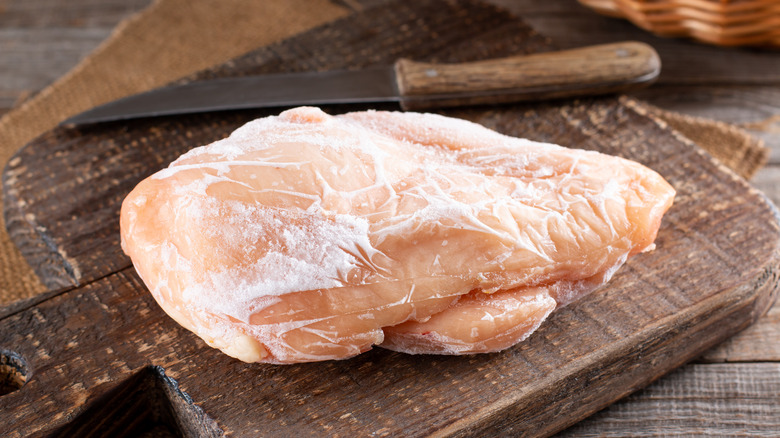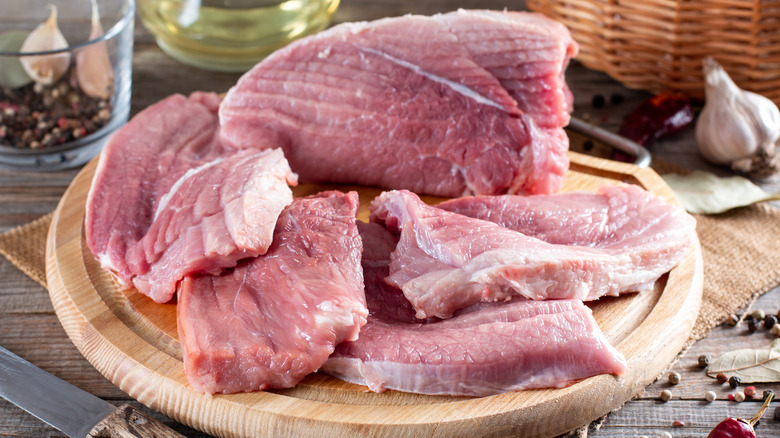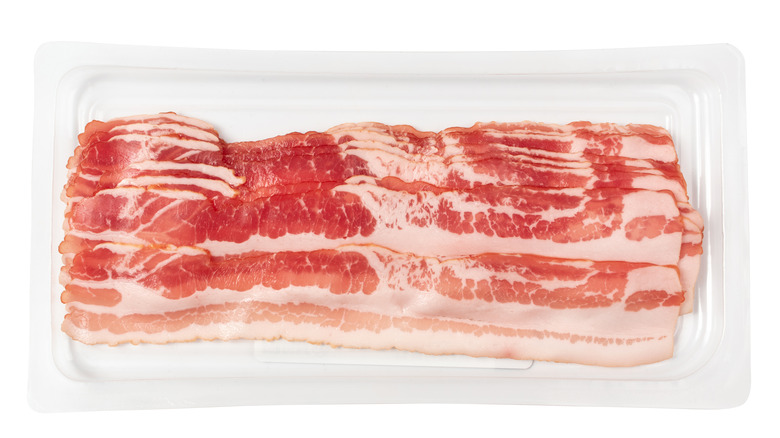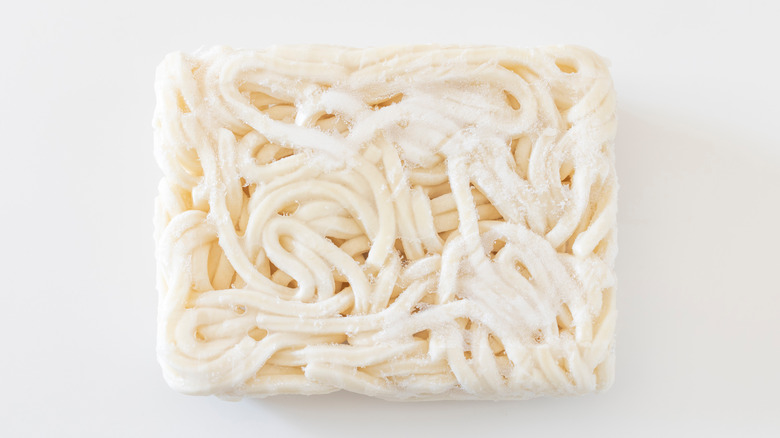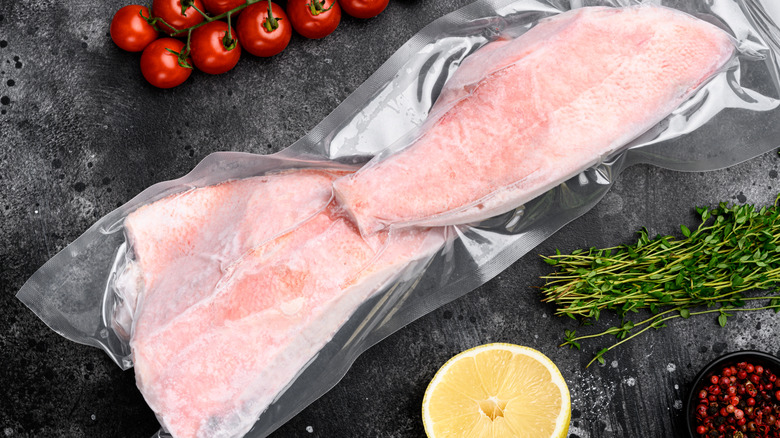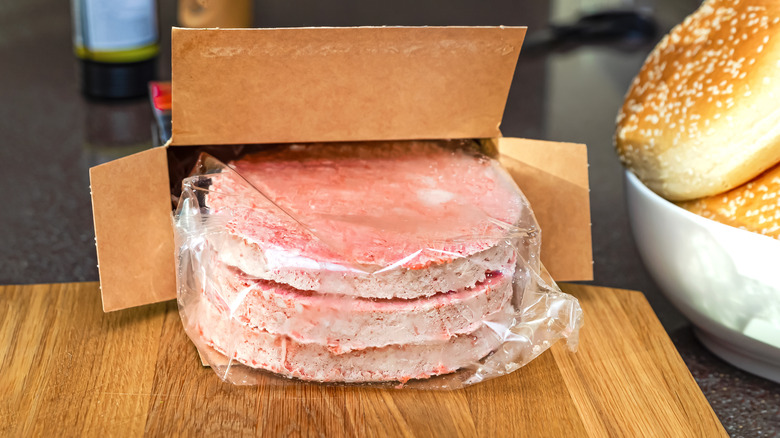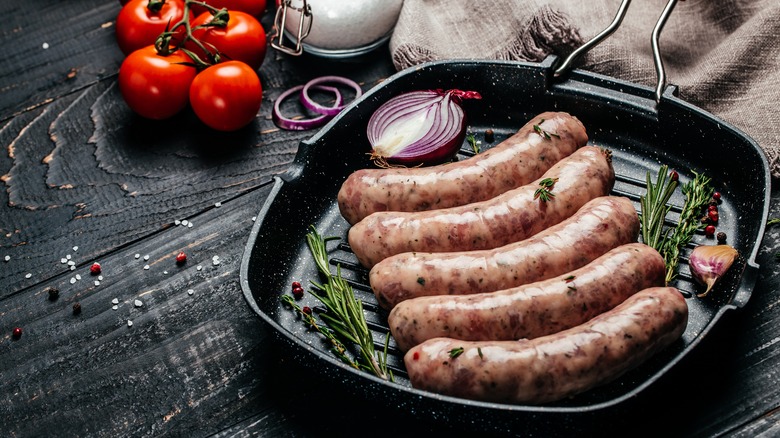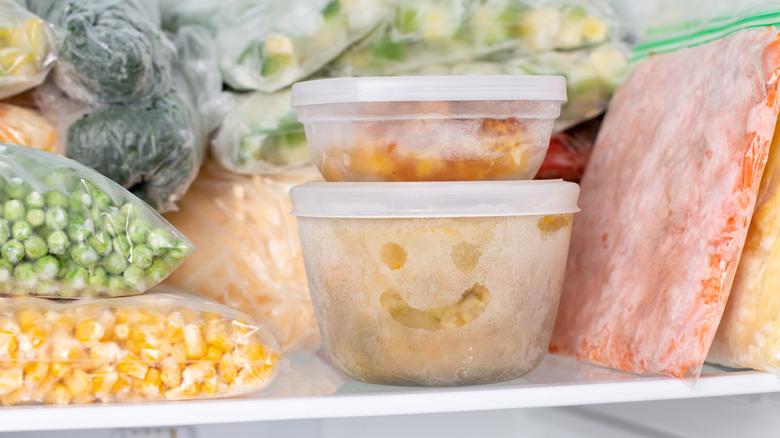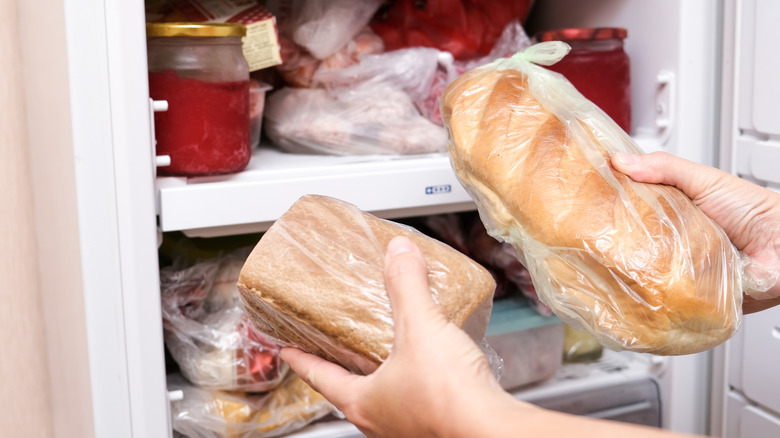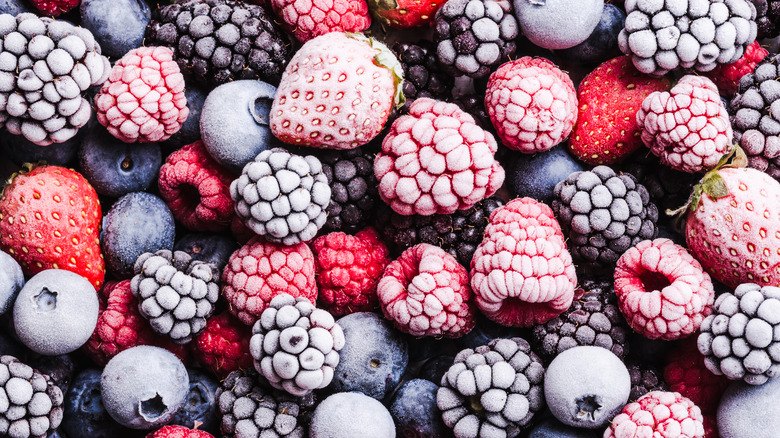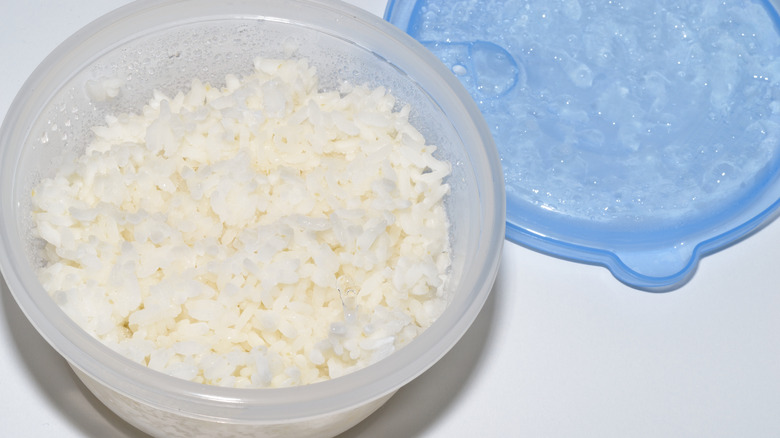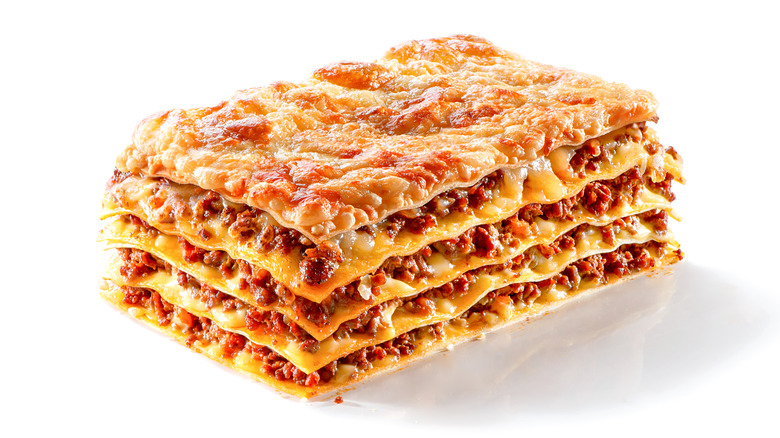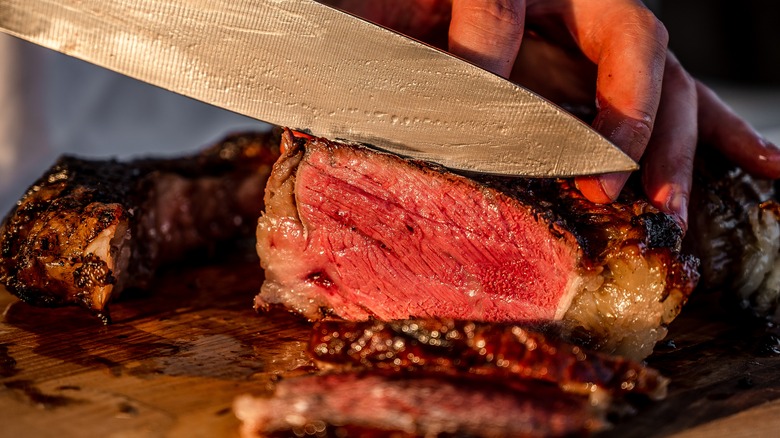Foods You Didn't Realize You Can Cook Straight From The Freezer
Keeping food at sub-freezing temperatures has become a way of life. Statista reports that in 2020 alone, U.S. companies shipped $33.9 billion worth of frozen foods — a jump of almost 40% from 2007. It's such a popular storage method that, in a 2021 survey by Tyson Foods, 55% of respondents said they own multiple freezers. Even award-winning chef Andrew Zimmern admits to being a fan of frozen food, saying that ability to freeze fresh food for later has a lot of perks.
The frozen food mania is about more than just convenience. The USDA notes any food stored at a temperature of 0 degrees Fahrenheit "will always be safe." It's a proven way to stop the growth of microorganisms that cause food spoilage so your products last months rather than days.
The question is, how do you cook all that food in cold storage? It's well-known that some meals such as frozen TV dinners and pizza can be cooked without thawing first. But the list of foods you can cook from frozen is a long one. WebMD states that, although thawing makes many foods cook faster, it's not a requirement for great results. So if you forgot to take something out to thaw before heading to work, don't fret. Check out these foods you can cook straight from the freezer and find something to enjoy.
Chicken
Some of you are undoubtedly familiar with waiting ... and waiting ... and waiting for poultry to thaw. The USDA says the safest way to thaw raw chicken is in the refrigerator — and the process can take a day or two using this method. Even defrosting chicken in cold water can take 2-3 hours for a whole bird — and you have to frequently change the water.
Fortunately, neither process is necessary for delicious chicken. In their AskUSDA knowledge database, the USDA has stated it's perfectly okay to cook frozen poultry. Their rule of thumb is that frozen chicken should be cooked about 50% longer than fresh chicken. So if the normal cooking time for raw chicken breast is 35 minutes, plan on 70 minutes for frozen pieces — which is still much less time than waiting for it to thaw. WikiHow adds the main thing is making sure the bird is cooked all the way through, which means an internal temperature of at least 165 degrees.
The oven and stovetop are both acceptable ways to cook chicken from frozen. However, using a slow cooker for frozen chicken is a no-no. Livestrong explains that it will take the meat much longer to cook through than raw chicken, which increases the possibility of food poisoning.
Pork
"The other white meat" is another meat that takes a long time to thaw. Pork manufacturer Prairie Fresh says frozen pork chops need to sit in your fridge for 12-14 hours to thaw, while roasts can take 3-7 hours per pound. So if you're planning to cook a 10-pound frozen roast, you're looking at up to 70 hours of waiting — and Prairie Fresh explicitly says no to speeding things up by leaving it on the kitchen counter.
So what are you to do? Just remove the packaging and take your pork straight from the freezer to the oven. Again, it will take longer to cook than fresh pork, so adjust accordingly. eHow notes that while most thawed meats take about 20 minutes per pound to cook, you should add 10-20 minutes of cook time for each pound when starting from frozen. The University of Missouri Extension also suggests using an oven temperature 25 degrees lower than you would with thawed meat to help it cook more evenly.
Like with chicken, it's also not recommended to cook frozen pork in a slow cooker, as it won't reach a bacteria-killing temperature fast enough. But there is one other cool note: Freeze It confirms you can put any leftover cooked pork back in the freezer. It will keep its quality for up to three months so you don't have to eat leftovers for days.
Bacon
It's not just dinner meats that you can prepare without thawing. Coleman Natural Foods says it's acceptable to cook bacon straight from the freezer. The process is a little trickier than with other cuts of meat because you have to separate the pieces to thoroughly cook them. This is easiest to do when the bacon is thawed, and it's practically a requirement if you want to wrap asparagus or scallops in bacon. Express even acknowledges that cooking bacon while it's still frozen isn't the ideal option.
That being said, if you just want crispy bacon strips with no frills, then thawing isn't necessary. WikiHow says you should first try to either pull the pieces apart by hand or pry them apart. If you're not able to separate the bacon into clean strips, you can either run the bacon under cold water for a few minutes to loosen it up or heat the entire block in a frying pan over low heat, pulling the strips off with tongs and setting them aside as they come loose.
As soon as this is complete, simply cook the bacon using your normal method while adding a few extra minutes. Oven, stovetop, microwave — you name it. Frozen bacon can even be cooked in an air fryer.
Fresh pasta
If you've ever made or purchased fresh pasta, you know dry pasta in a box just doesn't compare. As Pasta Evangelists will tell you, making or buying fresh pasta is a great way to enjoy a restaurant-quality Italian meal on special occasions. But it only lasts for a couple days in the refrigerator, which usually means having to freeze some for later.
The good news is that cooking fresh pasta from frozen is ridiculously easy. Both Freeze It and The Pasta Shop say there are no special instructions when it comes to this — you just drop the pasta directly into boiling water as normal. Adding as little as 30-60 seconds to the cooking time should be enough to account for the pasta's colder starting temperature.
There is one caveat: For cooking frozen pasta to be this simple, you need to freeze it the correct way. If you just throw the noodles into the freezer, they'll stick together in one big clump. Pasta Evangelists advise letting the pasta dry on a baking sheet for 15 minutes before freezing it. You can also try the "flash freeze" method recommended by Better Homes & Gardens where you separate the pieces and freeze them for two to three hours before packaging.
Fish
You don't need to buy fresh fish to enjoy a tasty and nutritious seafood meal. Livestrong notes that, in most cases, frozen fish is just as healthy as fresh fish. This is because the fish is usually frozen right after being caught, which locks in the nutrients and makes it easier to ship.
Furthermore, as long as the fish was pre-gutted, cooking it straight from the freezer isn't much different. WikiHow says the main added steps are to rinse the fish in cold water and pat it dry before cooking. This will get rid of any surface ice crystals and excess moisture. In most cases, it takes about double the time to cook frozen fish. For thick pieces, wrapping the fish in aluminum foil can reduce cooking time by locking in hot steam.
Whichever way you're cooking fish, it's particularly important to follow safe food practices. Although freezing food inactivates microbes such as E. coli, it doesn't kill them, so anything that was already on the fish can jump to you if you're not careful (via NPR). Remember to wash your hands thoroughly before and after handling fish, even if it's frozen. And make sure it's cooked all the way through — a USDA study found that nearly half of people incorrectly believe frozen food is fully cooked when it actually isn't.
Burgers
We'll start by saying many burger aficionados frown on the idea of cooking burgers from frozen. Even in an article talking about how to do so, Food Fire Friends admits that letting the patties thaw will produce the best results.
But not everyone has the time and space for this — unless we're talking about the space in their hungry belly. So by making a few adjustments to your technique, you can still end up with an appetizing taste of summer. BirdsEye offers ways to cook frozen burgers using a grill, a charcoal barbeque, or the oven to savor their juicy flavor. The oven method makes it easier to have a burger in the winter, too. (Just remember to convert their temperatures from Celsius to Fahrenheit if needed.)
The key here is patience. You should use a slightly lower heat than you would with fresh burgers — Food Fire Friends advises 325 degrees for the grill. If you crank the heat too high, you'll end up with a burned outside and undercooked center. Speaking of which, as with any meat, you need to make sure the insides have reached the recommended temperature. Per the Minnesota Department of Health, this is 160 degrees for ground beef and 165 degrees for a turkey burger.
Sausage
Sausage is the rare food appropriate for any meal — and fittingly, Commodious says the question they're asked the most is whether you can cook them when frozen. The short answer is yes, you can. For starters, if the sausage was sold in the frozen food aisle, it's usually meant to be cooked without thawing. All you have to do is pick up your favorite freezer sausage package — which is likely to be Banquet, according to Statista — and follow the instructions provided.
You also can usually freeze fresh or refrigerated sausages and cook them later without thawing. Livestrong notes that some brands are okay when you transfer the frozen sausages directly to the oven, stovetop, or grill. Other brands have instructions on the packaging stipulating you thaw the sausage first. Regardless, always check that it has reached the proper internal temperature. This will be either 160 or 165 degrees depending on the type of meat that was used (via FoodSafety.gov).
One potential drawback of freezing sausages yourself is that they can end up stuck together, giving you no choice but to thaw them. Freeze That Food endorses flash-freezing to keep this from happening — with the bonus that you can take out just one or two sausages to cook at a time instead of having to use the full batch.
Homemade soup
Soup may be the closest thing to a universally accepted food, with 95% of people saying they like or love it (via Business Wire). And if you're making homemade soup, you can store it in the freezer and then cook it up later. According to Weight Watchers, frozen soups and stews will retain their quality for two to three months. Heating it up is straightforward, too. Simply place the frozen soup in a saucepan over low heat and stir regularly. You may need to double or even triple the reheating time for the best results, but that's still better than letting it thaw completely.
But how do you get the frozen liquid into a saucepan? Old World Garden Farms says to make "soup bricks." By freezing the soup in containers overnight, popping the blocks out, and transferring them to sealed bags, you'll make reheating them later a breeze. This also lets you create individual portion sizes.
Yahoo! adds that, if you're planning to freeze homemade soup, you should undercook the vegetables and freeze starches such as rice and pasta in separate containers. This will prevent both from getting mushy when you reheat the soup. Adding seasonings and crunchy toppings while reheating will also help restore the original flavor and texture.
Bread and pastries
Pre-cooked bread slices will defrost in as little as 15 minutes at room temperature, per Love Food Hate Waste, meaning that most people simply don't worry about cooking it from the freezer. However, we realize sometimes you don't even have 15 minutes to spare. When this is the case, simply toss a frozen slice directly into the toaster or on the grill — it will only take a little bit longer to cook than thawed bread.
The same is true of many frozen pastries. Pastry makers such as Mary Jenkins Farm Shop often provide instructions for how to cook croissants, Danishes, cinnamon swirls, and other tasty treats without thawing first. This lets you enjoy them even longer, as most bread products will last two to six months in the freezer compared to three to five days on the counter (via Busby's Bakery). A study in the European Journal of Clinical Nutrition even found that toasting frozen bread can lower the glycemic response so you don't get as big a blood sugar spike.
One thing is important to know, though: Although you can freeze raw bread dough, you should never bake it directly from the freezer. Masterclass says this is because the dough needs a "second rise" to improve the quality. This additional rise can only happen at room temperature.
Fruit
Fruits are seasonal crops, which means fresh apples, berries, and other produce aren't always available. Fear not, though — the inimitable Martha Stewart writes that you can cook with frozen fruit directly from the freezer. Stir berries into oatmeal before cooking it or make pies, fruit crisps, sauces, and other delectable dishes.
Another famous Martha baker, Martha White, offers some advice when baking with frozen fruit. Moisture is added during the freezing process, which makes the pieces heavier than fresh fruit. Tossing frozen fruit in some flour or cornstarch first will keep it from sinking to the bottom of your batter. Adding a little extra flour or other thickeners to the mixture will help soak up this extra moisture. If you have dark fruit, rinse and pat dry first so the color is less likely to bleed.
Cooking frozen fruit also accounts for fundamental changes that occur during the freezing process. The University of Minnesota Extension explains that, as the water inside fruit freezes, it expands and breaks down cell walls, causing a softer texture when thawed. Mixing frozen fruit into things while it's still solid will help prevent any mushiness. If you're freezing the fruit yourself, just remember that you should blanch it first to deactivate the enzymes that otherwise cause nutrients, flavor, and color to fade away, giving you a tastier final product.
Cooked rice
Tired of leftover rice spoiling before you can eat it? Simply freeze the rice and then recook it later. The University of Nebraska-Lincoln states that frozen rice can go directly in soups and other fare. This takes care of one of reheated rice's biggest drawbacks: It dries out fast because of how the starch molecules change when they're cooled. Cooking frozen rice in a high-moisture food helps restore the original texture. If you're reheating frozen rice by itself in the microwave or on a stovetop, Insider suggests adding one tablespoon of water for each cup of rice and covering the container to effectively re-steam it.
There's another hidden benefit of cooking rice from the freezer. A study in the Asia Pacific Journal of Clinical Nutrition discovered that cooling rice and then reheating it lowers the glycemic response and creates more "resistant starch." In other words, the rice doesn't affect your blood sugar as much — and BBC One says the resistant starch means you take in fewer calories and improve gut bacteria health. That's two great reasons to cook with frozen rice.
Minced meat
Finely chopped meat, often known as mince, is great to keep in the icebox. Express describes it as a "cheap and versatile ingredient" that is easy to freeze. And whether mince is made from beef, turkey, lamb, or other meat, it can be cooked the moment you take it out. CPD Online College says the cooking process is almost identical to cooking fresh mince. Start by placing the frozen block in a stovetop pan over low heat and moving it around so the meat thaws and separates more evenly. When it has fully separated, turn the heat up to finish cooking. The whole process takes as little as 10-15 minutes.
When cooked properly, your frozen mince will be pretty much the same as fresh mince in taste and texture. But remember to cook it all the way through. Mince often has food bacteria and viruses on the inside as well as the outside, and FoodSafety.gov reminds us that these microbes are the number one source of food poisoning. So use proper precautions and make sure to read any package instructions. Otherwise, you could end up one of the 48 million Americans who get food poisoning annually (via the Centers for Disease Control and Prevention).
Steak
Cultured carnivores know there's a steak for almost any occasion. But whether you're preparing a grocery-store sirloin or a high-end ribeye, you can certainly cook steak directly from the freezer. In fact, it may be a better option than thawed steak. Experiments by Cook's Illustrated found that, although they take longer to cook, frozen steaks brown just as well as fresh ones when seared. They also had smaller "gray bands" of overcooked meat, retained more moisture, and simply tasted better.
These findings are echoed by Epicurious, which went on to explain the phenomenon. ThermoWorks' Eric Robinson told the publication that by freezing a steak, you can sear it at an extremely high temperature without overcooking the inside. The result is a well-browned exterior and a perfectly pink or red center.
There are multiple ways to cook steak from frozen. One method involves searing the steak for 90 seconds on each side, then finishing it in the oven for 18-22 minutes at 275 degrees. Another option is to sear your steak on one side only and then oven-cook it for a shorter time at a higher temperature. Either way, use a meat thermometer to confirm the correct internal hotness. This chart from Traeger shows when steaks are considered rare, medium rare, etc., so you get it just right.

